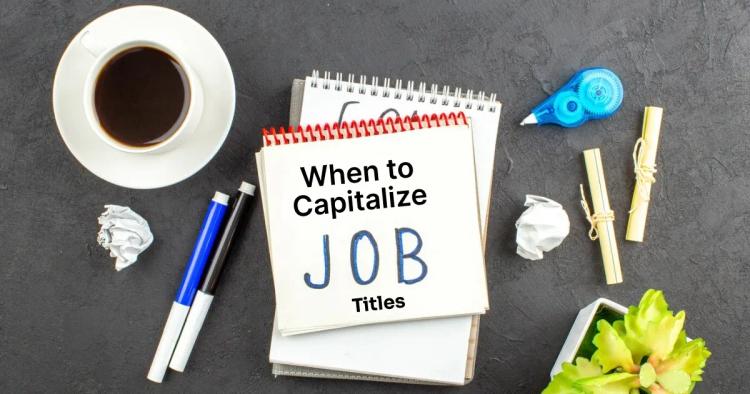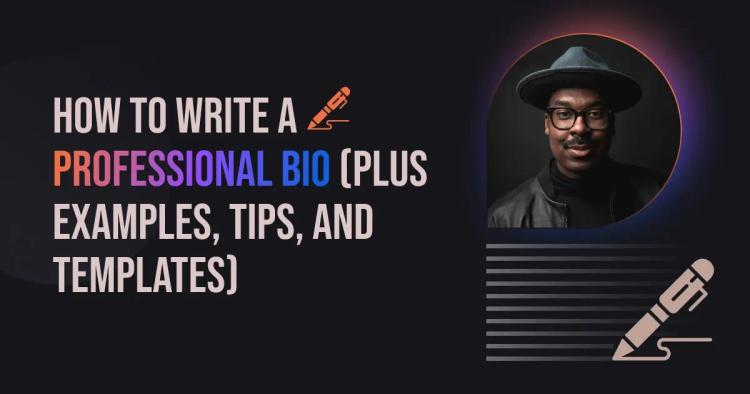In the age of instant messaging and social media, writing and sending a postcard might seem like an outdated concept. However, sending a postcard is a simple yet thoughtful gesture that can brighten someone's day and make them feel special.
It's a way of showing someone that you're thinking of them and want to share a little piece of your travels or experiences.
In this blog post, we'll walk you through the process of writing a postcard, from understanding the different types of postcards to addressing and sending them, and even provide some sample postcards to give you some inspiration.
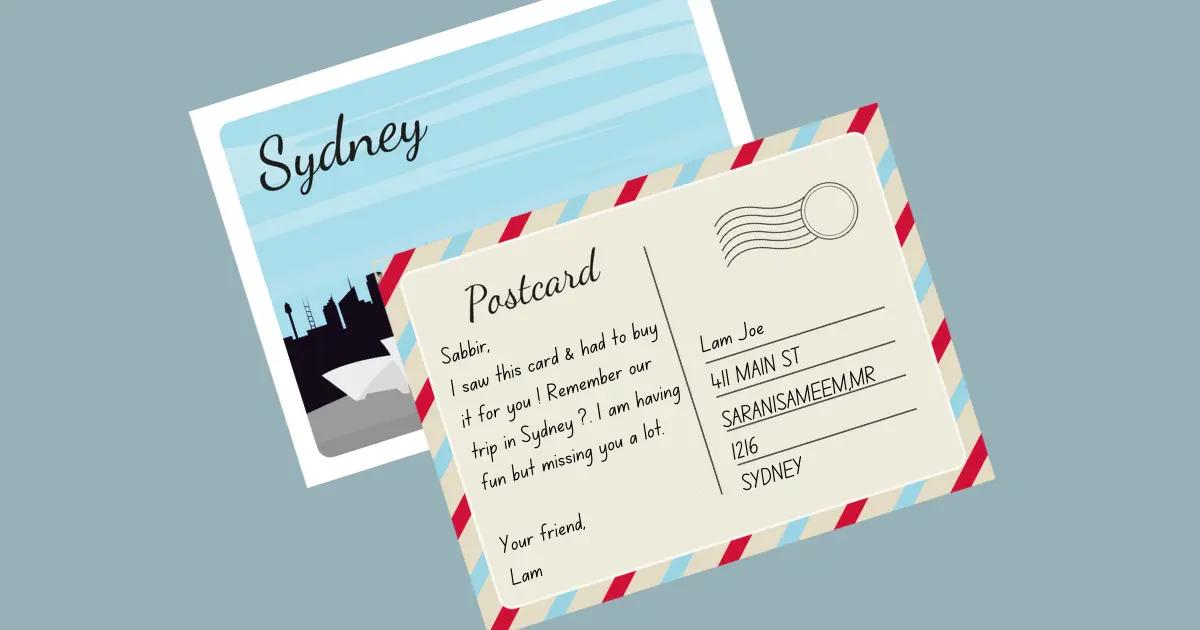
ᴀᴅᴠᴇʀᴛɪsᴇᴍᴇɴᴛ
Understanding Postcards
What is a Postcard?
Postcards are rectangular pieces of cardstock or paper that are designed to be mailed without being placed in an envelope. One side of the postcard typically features a photograph or illustration, while the other side is reserved for a handwritten message and the recipient's address.
Postcards have been around for over a century and were originally used as a way for people to keep in touch while traveling.
Brief History of Postcards
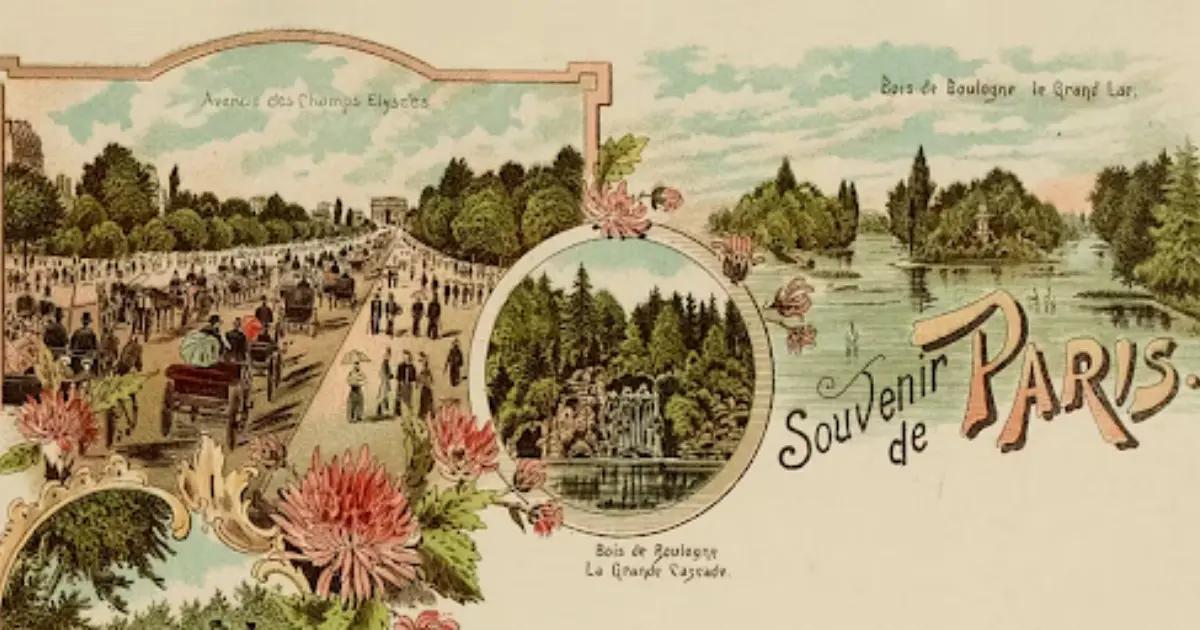
The first postcards were introduced in Austria in 1869 and quickly gained popularity across Europe. The United States began producing postcards in 1873, and by the turn of the century, postcards had become a popular souvenir for travelers.
Postcards have gone through many changes over the years, from the early black-and-white photos to the colorful, illustrated cards we see today.
Why send Postcards?
Sending a postcard has several advantages over other forms of communication. For one, it's a tangible object the recipient can hold and keep as a memento. It's also a way of sharing your travels or experiences with someone in a more personal way than simply posting a photo on social media.
Finally, sending a postcard shows that you took the time to think of someone and wanted to share a little piece of your adventure with them.
Types of Postcards
There are several types of postcards to choose from, depending on your purpose and personal preferences.
Tourist postcards: These are the most common type of postcard and typically feature a photograph of a popular tourist destination or landmark.
Art postcards: These postcards feature reproductions of famous artworks or photographs of unique or interesting pieces of art.
Vintage postcards: Collectors often seek out vintage postcards, which can be valuable depending on their age and condition.
Personalized postcards: If you want to create a truly unique postcard, you can design your own using your photographs or artwork.
Choosing a Postcard
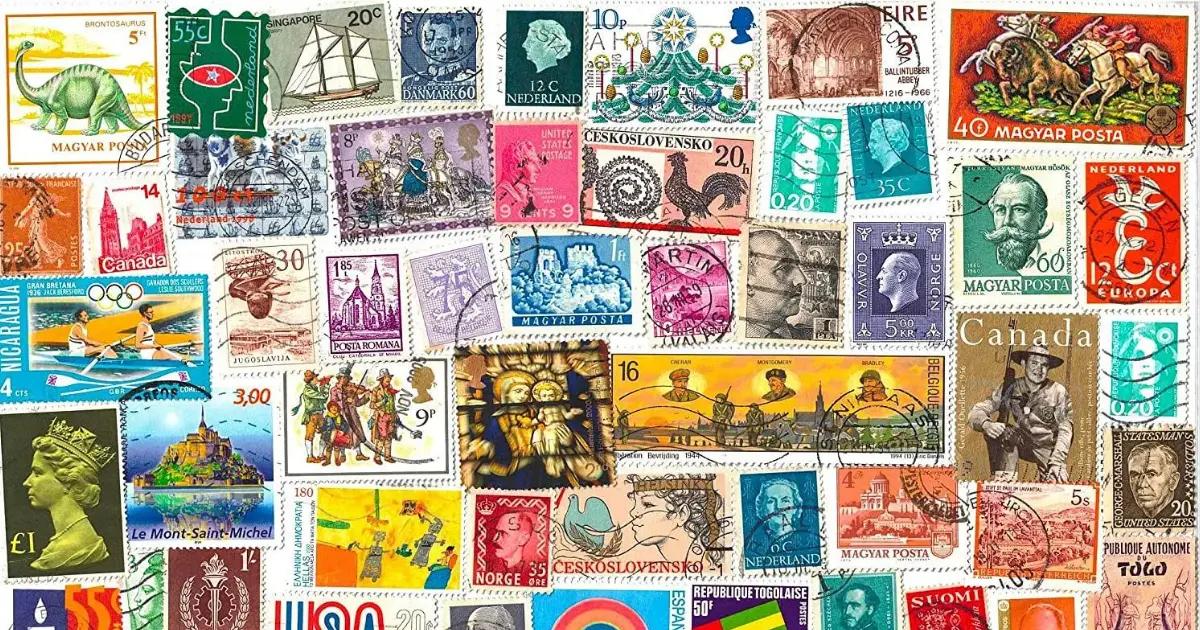
Consider your Purpose
When choosing a postcard, consider your purpose for sending it. Are you sending a greeting, sharing your travel experiences, or inviting someone to an event? This will help you choose the right postcard for your message.
ᴀᴅᴠᴇʀᴛɪsᴇᴍᴇɴᴛ
Look for Postcards that suit your needs
You can find postcards in many places, including souvenir shops, bookstores, and online retailers. When choosing a postcard, think about the recipient's interests. For example, if they love animals, look for a postcard with a picture of wildlife.
Purchase or Create your Postcards
You can purchase postcards in stores or online. You can also create your postcards using your photos or artwork. Many online services allow you to design and print your postcards.
Composing Your Message
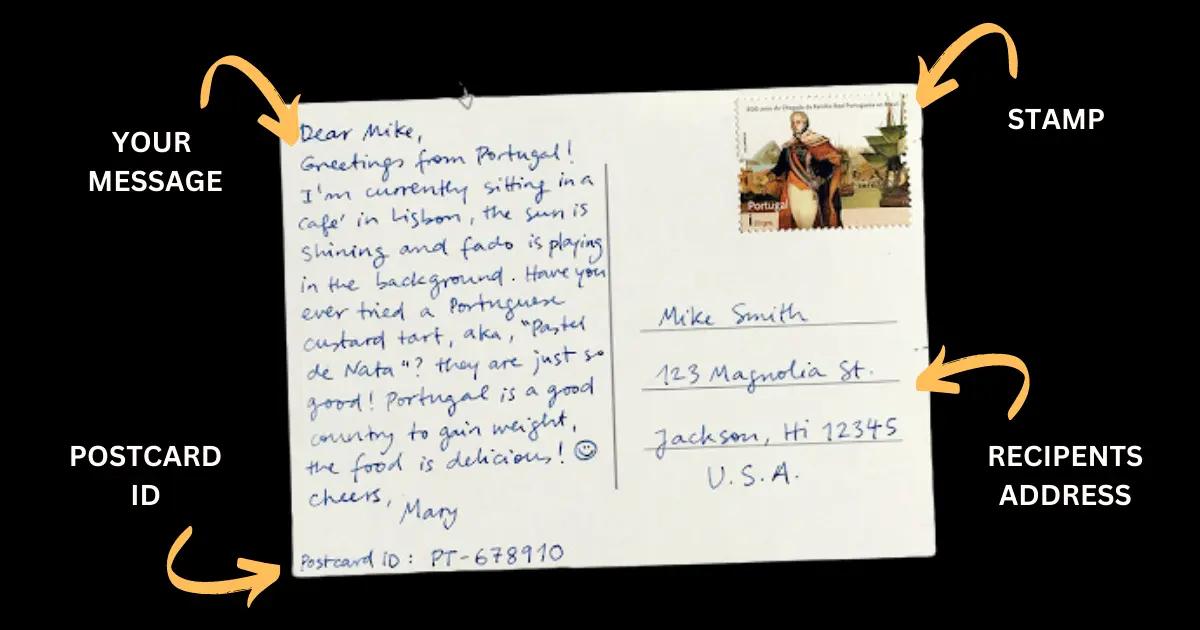
Once you have your postcard in hand, it's time to start composing your message. This is where you get to share your experiences, thoughts, and feelings with the recipient. Here are some tips to help you write a great postcard message:
Begin with a Greeting
Start your message with a friendly greeting. This can be as simple as "Dear [recipient's name]," or "Hello from [location]!" Here are some examples of greetings you can use:
- Greetings from [location]!
- Hey there, [recipient's name]!
- Howdy from [location]!
- Hello from [location]!
- Hi [recipient's name]!
- Salutations from [location]!
- Warm wishes from [location]!
Personalizing the Greeting based on the Recipient
Consider personalizing the greeting based on the recipient. If you're sending a postcard to a friend, you might start your message with "Hey there, buddy!" or "Hi [friend's name]!" If you're sending a postcard to a family member, you might start your message with "Dear [family member's name]," or "Hello, [family member's name]!"
Share your experience.
The main purpose of a postcard is to share your experiences with the recipient. Here are some tips on how to do that:
Describe what you see
Take a look around you and describe what you see. Use descriptive language to help the recipient visualize your location. For example, instead of saying "I'm at the beach," you could say "I'm sitting on a white sandy beach, watching the waves crash against the shore.
Highlighting unique features of the location
If there's something unique or interesting about your location, be sure to mention it. For example, if you're in Paris, you might mention the Eiffel Tower or the Louvre Museum.
Share what you've done
In addition to describing your surroundings, you can also share what you've been up to. Highlight interesting activities or experiences that you've had. For example, if you're in Hawaii, you might mention that you went surfing or attended a traditional luau.
ᴀᴅᴠᴇʀᴛɪsᴇᴍᴇɴᴛ
Providing details about local culture or history
If you're visiting a location with a rich cultural or historical background, share some of that information with the recipient. For example, if you're in Japan, you might mention the significance of cherry blossom season or the history of samurai warriors.
Mention who you're with
If you're traveling with others, mention them in your message. Share details about your travel companions and express gratitude for their friendship. For example, you might say "I'm having a great time exploring [location] with my best friend. We've been having a blast trying all the local cuisine!"
Ask Questions
Asking questions is a great way to encourage the recipient to respond to your postcard. Here are some examples of questions you can ask:
- What have you been up to lately?
- Have you ever been to [location] before?
- What's the weather like back home?
- How's [family member's name] doing?
- What's new with [mutual friend's name]?
Encouraging the recipient to respond
Make sure to encourage the recipient to respond to your postcard. Let them know that you're looking forward to hearing back from them. For example, you might say "I can't wait to hear all about what's been going on with you lately. Send me a postcard back soon!"
Sign off
After you have finished writing the body of your postcard message, it's time to sign off. This is where you bid farewell to your recipient and wrap up your message. You can choose a standard sign-off or personalize it based on your relationship with the recipient.
Here are some examples of signoffs you can use:
- Best regards
- Yours truly
- Love
- Sincerely
- Warm wishes
- All the best
- Take care!
Personalizing the sign-off based on the recipient can add a nice touch to your postcard. For example, if you're writing to a close friend, you might use "Love" or "XOXO" as your sign-off. If you're writing to a family member, you might choose "Warm wishes" or "Yours truly."
ᴀᴅᴠᴇʀᴛɪsᴇᴍᴇɴᴛ
Addressing and Sending Your Postcard
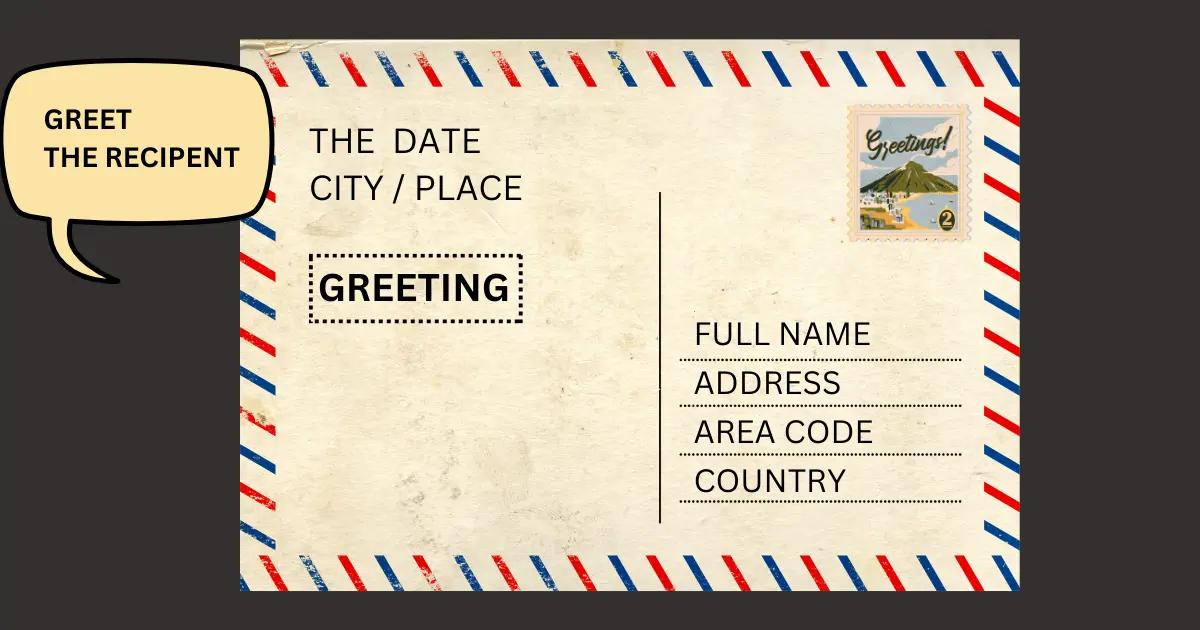
Now that you've composed your postcard message, it's time to address it and send it on its way. Addressing a postcard correctly is important to ensure it gets delivered to the right person. Adding postage is also crucial, as this covers the cost of delivering your postcard to its destination.
Addressing your Postcard.
When addressing a postcard, there are a few things to keep in mind:
- Write the recipient's name and address on the right-hand side of the postcard.
- Write your name and address on the left-hand side of the postcard.
- Make sure the address is legible and accurate.
- Use the correct format for the country you're sending the postcard to.
Here's an example of how to format an address on a postcard:
[Recipient's Name] [Street Address] [City, State/Province] [Postal/Zip Code] [Country]
For Example:
John Smith 123 Main Street Los Angeles, CA 90001 United States
Adding Postage
The amount of postage you need to add to your postcard will depend on the destination and the size of the postcard. Check with your local post office or postal service to find out the current rates and regulations.
To affix postage, place the stamp in the upper right-hand corner of the postcard. Make sure the stamp is securely attached and not upside down.
Sending your Postcard.
Once you've addressed your postcard and added postage, it's time to send it on its way. You can drop it off at a mailbox or post office, or hand it to a postal worker. If you're sending the postcard from a foreign country, make sure to ask the postal worker about any additional requirements or regulations.
If you're interested in tracking the delivery of your postcard, you may be able to do so online. Check with your local postal service to find out if this option is available.
ᴀᴅᴠᴇʀᴛɪsᴇᴍᴇɴᴛ
Tips and Warnings
Tips for Writing a Great Postcard
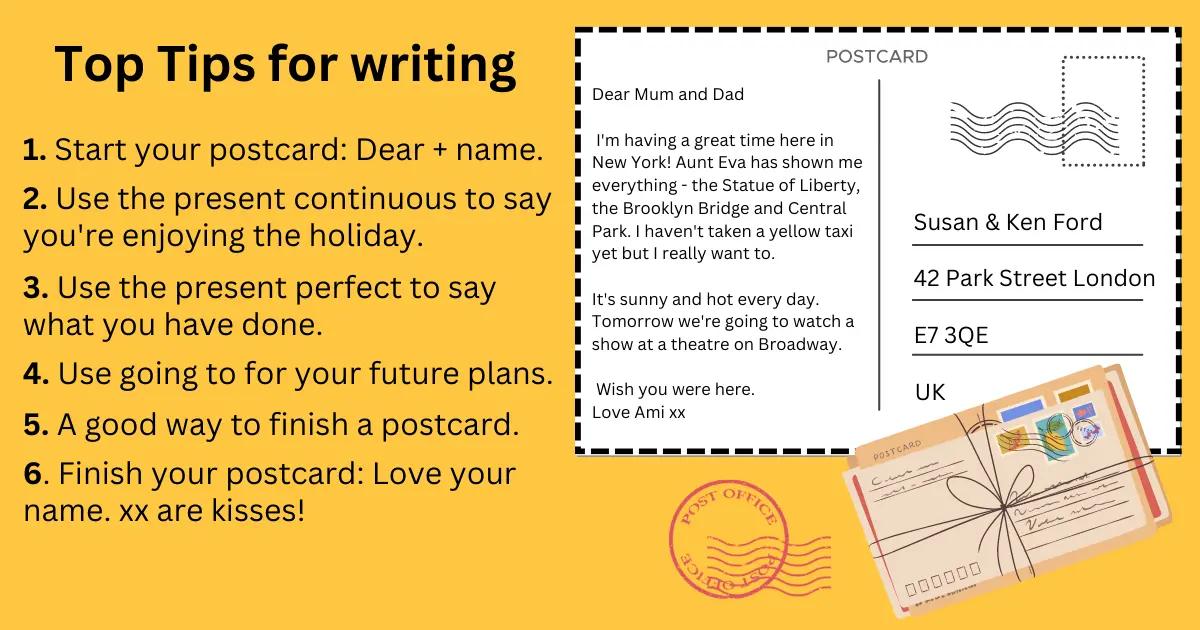
Writing a postcard can be a fun and rewarding experience. Here are some tips to help you write a great postcard:
- Use descriptive language to bring your message to life.
- Share interesting details about your location or experiences.
- Use humor or wit to make your recipient smile.
- Add personal touches like stickers or drawings to make your postcard unique.
- Keep your message brief and to the point.
Common Mistakes to Avoid
While writing a postcard is relatively simple, there are a few common mistakes to avoid:
- Including inappropriate content or language.
- Writing illegibly or with poor grammar.
- Choosing a postcard that doesn't suit your needs or the recipient's interests.
- Forgetting to add postage or address the postcard correctly.
How Grammar Checker Can Help in Writing a Postcard
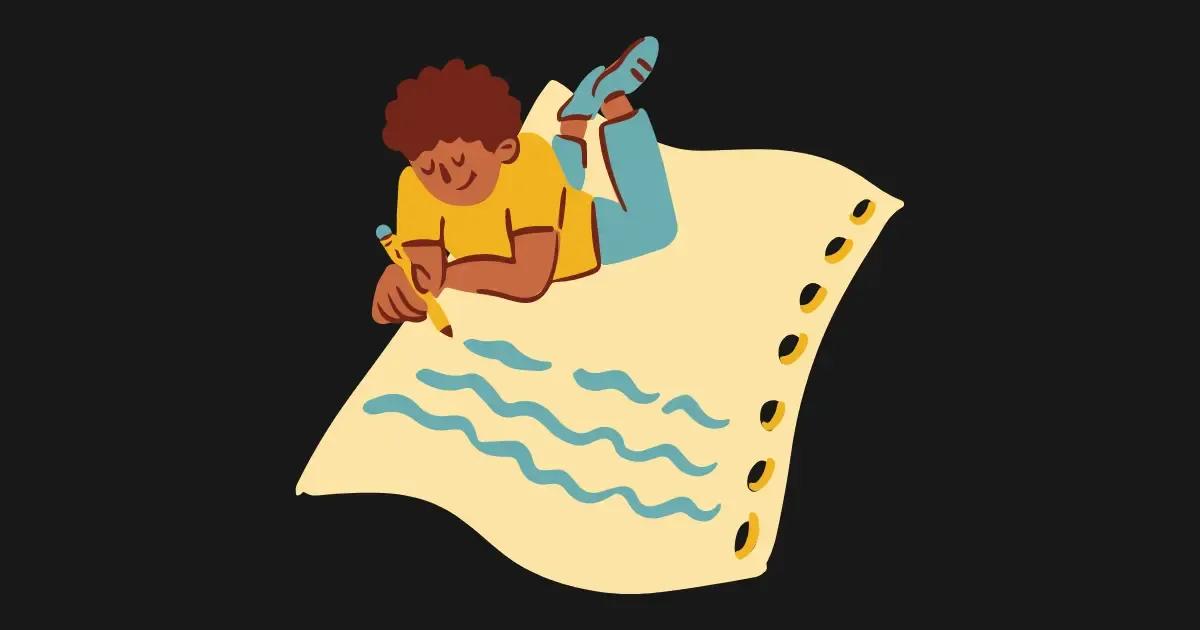
Grammar Checker is a useful tool that can help you write a postcard with confidence, ensuring that your message is clear, error-free, and engaging. Here are a few ways that Grammar Checker can assist you in writing a postcard:
Checking for Spelling and Grammar Errors
One of the most important aspects of writing a postcard is making sure that your message is free of spelling and grammar errors. Grammar Checker can scan your message for errors and provide suggestions for corrections, allowing you to ensure that your postcard is professional and easy to read.
Analyzing Readability
Grammar Checker can also analyze the readability of your postcard, considering factors such as sentence structure, word choice, and complexity. This can help you identify areas where your message may be difficult to understand or unclear, allowing you to make improvements and create a more engaging message.
Providing Suggestions for Improvement
Grammar Checker can provide suggestions for improvement based on your message and the recipient. For example, if your message seems too formal or impersonal, Grammar Checker can suggest ways to make it more friendly and engaging.
Similarly, if your message is lacking in detail or specificity, Grammar Checker can suggest ways to make it more vivid and interesting.
By using Grammar Checker, you can ensure that your postcard is the best it can be, leaving a lasting impression on the recipient and making them feel closer to you.
ᴀᴅᴠᴇʀᴛɪsᴇᴍᴇɴᴛ
Sample Postcards
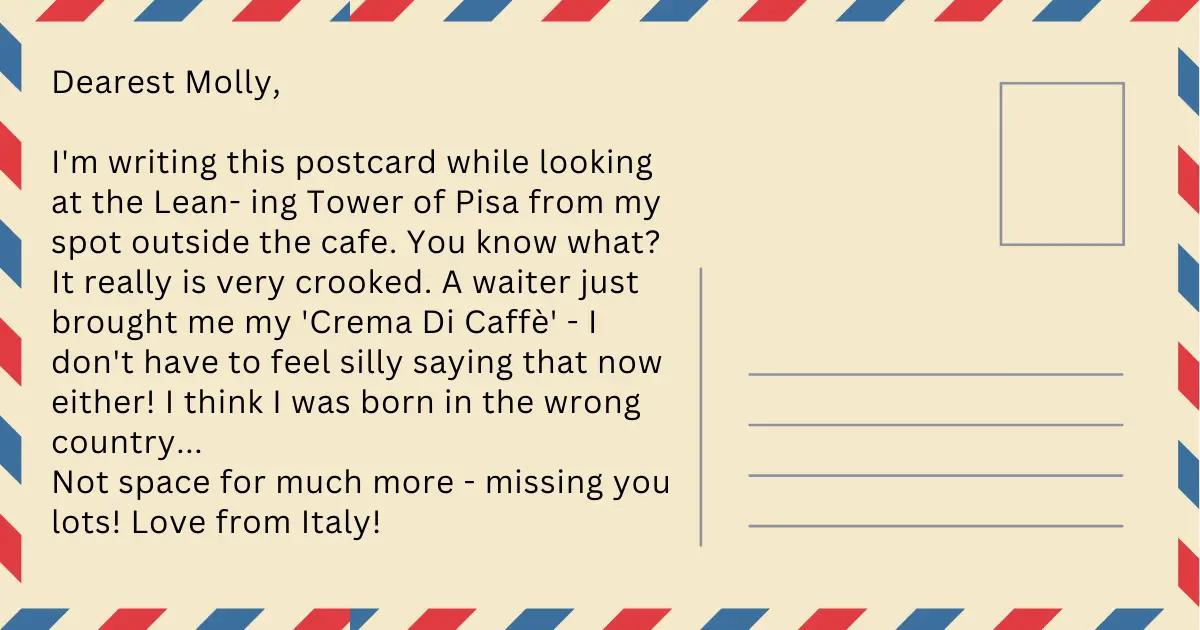
Example postcard 1
This postcard showcases how to highlight specific elements of the postcard and personalize the message for the recipient. Here's an example of how to write a postcard for this purpose:
Dear Sarah,
Greetings from Paris! I hope this postcard finds you well. I couldn't resist sending you this beautiful view of the Eiffel Tower. It's even more breathtaking in person! I know how much you love French cuisine, so I've been indulging in croissants and macarons every day. I wish you could be here to enjoy them with me.
I'm also thinking of you whenever I walk by the Seine River, where we took that lovely boat ride together. Remember how we saw the Notre Dame Cathedral from the water? It's such a shame it's closed for renovations now, but I'll make sure to take plenty of pictures when I visit it again next time.
Can't wait to catch up with you and hear about everything that's happened since we last spoke. Miss you lots!
Love, [Your Name]
In this postcard, the writer starts with a greeting and immediately sets the scene by sharing a specific element of the postcard - the Eiffel Tower.
By mentioning the recipient's interest in French cuisine, the writer personalizes the message and shows that they remember details about the recipient's likes and dislikes. Additionally, the writer brings up a shared memory of a boat ride on the Seine River, further strengthening their connection.
The postcard also ends with an invitation to catch up and a declaration of missing the recipient, making the message feel warm and sincere.
Overall, this postcard showcases how to personalize your message and highlight specific elements that will be meaningful to the recipient.
Example postcard 2
This postcard showcases how to share details about the location and ask questions to encourage a response. Here's an example of how to write a postcard for this purpose:
Hey Mark,
Greetings from Maui! The weather here is perfect - sunny and warm every day. I've been spending most of my time on the beach, soaking up the sun and listening to the waves. It's so peaceful here, I wish you could join me.
Yesterday, I went on a hike to the top of Haleakalā National Park. The views were breathtaking - I could see the ocean! Have you ever been hiking in Hawaii? If not, I highly recommend it.
I'm also planning on trying some of the local cuisine tonight. Have you ever had a poke? I hear it's a must-try dish here. Let me know if you have any other recommendations!
Can't wait to hear from you.
Best, [Your Name]
In this postcard, the writer starts with a casual greeting and immediately shares details about the location, including the weather and activities they've been doing. The writer also brings up a shared interest (hiking) and asks the recipient a question to encourage a response.
By mentioning local cuisine, the writer shows that they are exploring the culture and invites the recipient to be a part of it as well.
The postcard ends with an invitation to respond and a friendly sign-off, creating a sense of connection and anticipation for a response. Overall, this postcard showcases how to share details about the location and invite the recipient to participate in the experience.
FAQs
Here are some frequently asked questions about writing postcards:
How to Write a Postcard?
To write a postcard, choose a postcard with an image or design that suits your message. On the back of the postcard, write a short message that includes a greeting, a personalised message, and a closing.
Be sure to include the recipient's name and address on the right-hand side of the postcard and your own address and postage stamp on the left-hand side.
How to Write on a Postcard?
When writing on a postcard, use a pen with black or blue ink that will not smear or fade over time. Write your message on the back of the postcard, using clear and legible handwriting. Be sure to leave enough space for the recipient's address on the right-hand side of the postcard.
How to Write a Postcard Address?
To write a postcard address, start by writing the recipient's name and address on the right-hand side of the postcard. Use clear and legible handwriting, making sure to spell the recipient's name correctly and include all necessary details such as the street address, city, state, and country.
How to Write an Address on a Postcard?
To write an address on a postcard, start by writing the recipient's name and address on the right-hand side of the postcard. Use clear and legible handwriting, making sure to spell the recipient's name correctly and include all necessary details such as the street address, city, state, and country.
On the left-hand side of the postcard, write your address and add a postage stamp.
How to Write a Postcard to a Friend?
To write a postcard to a friend, start by choosing a postcard that suits your friend's interests or personality. On the back of the postcard, write a personalised message that includes a greeting, a friendly message, and a closing.
Share details about your experiences or ask questions to encourage a response. Be sure to include the recipient's name and address on the right-hand side of the postcard and your own address and postage stamp on the left-hand side.
ᴀᴅᴠᴇʀᴛɪsᴇᴍᴇɴᴛ
Conclusion
Writing a postcard may seem like a small gesture, but it can have a big impact on the recipient. By taking the time to share your experiences and connect with loved ones, you can make them feel closer to you, even when you are miles away.
To write a great postcard, start by choosing a postcard that suits your needs and composing a message that is personalized, thoughtful, and engaging.
Whether you're sharing specific elements of the postcard or asking questions to encourage a response, remember that the goal is to create a meaningful connection with the recipient.
So next time you're on vacation, don't forget to send a postcard - your loved ones will appreciate it more than you know.





